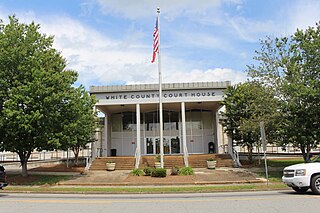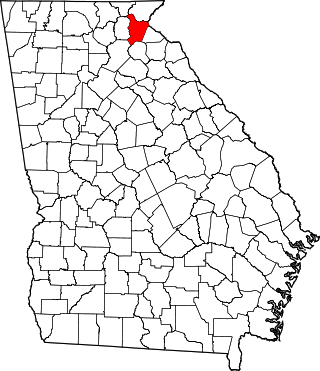
Clay County is a county located in the U.S. state of Arkansas. Originally incorporated as Clayton County, as of the 2020 census, its population was 14,552. The county has two county seats, Corning and Piggott. It is a dry county, in which the sale of alcoholic beverages is restricted or prohibited.

White County is a county located in the northeastern part of the U.S. state of Georgia. As of the 2020 census, the population was 28,003. The county seat is Cleveland. The county was created on December 22, 1857, formerly a part of Habersham County and most likely was named for Newton County Representative David T. White, who helped a Habersham representative successfully attain passage of an act creating the new county.

Habersham County is a county located in the northeastern part of the U.S. state of Georgia. As of the 2020 census, the population was 46,031. The county seat is Clarkesville. The county was created on December 15, 1818, and named for Colonel Joseph Habersham of the Continental Army in the Revolutionary War.

Banks County is a county located in the northeastern part of the U.S. state of Georgia. As of the 2020 census, the population was 18,035, down from 18,395 in 2010. The county seat is Homer. The Old Banks County Courthouse is located in Homer and listed on the National Register of Historic Places. A new county courthouse was constructed adjacent to the old one in 1983.

Hughson is a city in Stanislaus County, California, United States. It is part of the Modesto Metropolitan Statistical Area. The population was 7,481 at the 2020 census, up from 6,640 at the 2010 census.

Alto is a town in Banks and Habersham counties in the U.S. state of Georgia. As of the 2010 census, the town had a population of 1,172, up from 876 at the 2000 census.

Baldwin is a city in Banks and Habersham counties in the U.S. state of Georgia. As of the 2010 census, the city had a population of 3,279, up from 2,425 at the 2000 census.

Moreland is a town in Coweta County, Georgia, United States. As of the 2020 census, the town population was 382.

Brooks is a town in Fayette County, Georgia, United States. As of the 2020 United States census, it had a population of 568.

Clarkesville is a city that is the county seat of Habersham County, Georgia, United States. As of the 2020 census, it had a population of 1,911, up from the 2010 census population of 1,733, up from 1,248 at the 2000 census.

Demorest is a city in Habersham County, Georgia, United States. The population was 2,022 at the 2020 census, up from 1,823 at the 2010 census, and 1,465 at the 2000 census. It is the home of Piedmont University.

Mount Airy is a town in Habersham County, Georgia, United States. The population was 1,284 at the 2010 census, up from 604 at the 2000 census.

Raoul is an unincorporated community and census-designated place (CDP) in Habersham County, Georgia, United States. As of the 2010 census, the CDP had a population of 2,558, up from 1,816 at the 2000 census.

Ila is a city in Madison County, Georgia, United States. The population was 350 at the 2020 census.

Fort Valley is a city in and the county seat of Peach County, Georgia, United States. As of the 2020 census, the city had a population of 8,780.

Concord is a city in Pike County, Georgia, United States. The population was 375 at the 2010 census.

Campbell is a city in northern Dunklin County, Missouri, United States. The population was 1,992 at the 2010 census.

Ryan is a town in Jefferson County, Oklahoma, United States, located just north of the Texas state line. The population was 667 at the 2020 census.

Burton is a city in Washington County, Texas, United States. The population was 359 at the 2000 census. Prior to the 2010 census, Burton changed its status from a town to a city. The population was 300 at the 2010 census.

Lytle is a city in Atascosa, Bexar, and Medina counties in the U.S. state of Texas. The population was 2,492 at the 2010 census. It is part of the San Antonio Metropolitan Statistical Area.
























